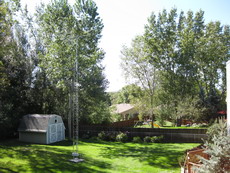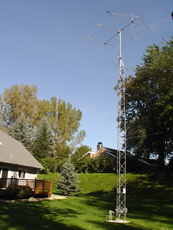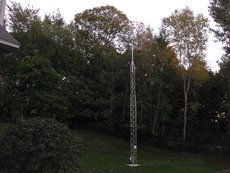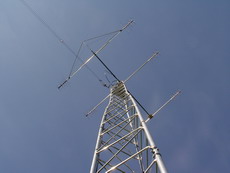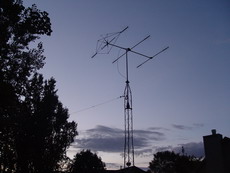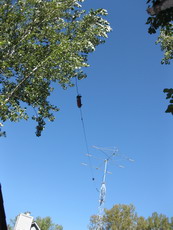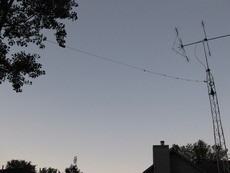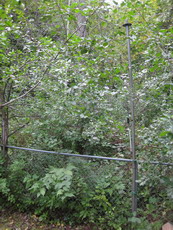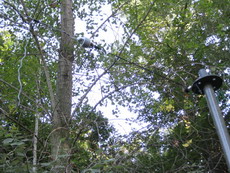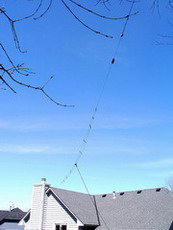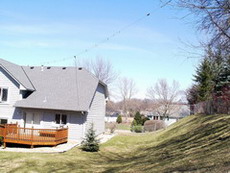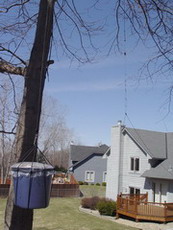Antennas
Last Updated on Wednesday, August 31, 2011 7:33 PM Written by N1WQ Friday, October 22, 2010 11:24 PM
In the August 2010 I have finally erected my tower. Although it is a small 30 ft tower, this project took me about two years. During all this time (and long time before this) I was guided by my friend Jim (K0JB), who has a lot of experience in this (and not only this) area. Besides of the tower, the project included grounding system consisting of 8 ground rods with CAD-welded connections between them, and about 100 ft long underground conduit run for cables with remote antenna switch (6-port RatPak model from Array Solutions) approximately in the middle of it, at the corner of my house.
The tower is a free standing aluminum tower, model #12-30 from Universal Towers.
All outside coaxial cable runs are made of Bury-FLEX cable from Davis RF. The inside RG-213 coax, and all control cables came from the same company. Amphenol 83-1SP series PL-259 connectors are used for all outside and most inside connections (with the remaining connectors coming from Davis RF). Shakespeare RA-259-239-G series right-angle PL-259 to SO-239 adapters are used wherever the space does not permit direct connector to socket attachment.
The multistage lightning protection system consists of Alpha Delta Communications ATT3G50UHP coax surge protectors, and Array Solutions AS-8SP and Polyphaser IS-RCT control cable surge protectors.
TGM MQ-36SR
The antenna on the top of the tower (approximately 36 ft up) is MQ-36SR hybrid mini-beam from TGM Communications. This is 3 element yagi with coils, spokes and quad-style reflector, although some people think there is nothing “quad” in this antenna, and the reflector is just a “fat” one, merely resembling the quad design.
This antenna has very small footprint and it is very lightweight. The usual tradeoff for these conviniences is rather narrow bandwidth, modest gain and not quite straightforward directivity. I tuned it up for CW portions of all 5 bands (10M-12M-15M-17M-20M). The antenna tuner allows me to work PSK and RTTY as well. On 10M and 12M bands the antenna also covers entire SSB portion with pretty low VSWR.
The balun used with the antenna is Balun Designs model 1113t.
The rotator is Yaesu G-800DXA.
Alpha-Delta DX-B
For lower bands I have quarter wave sloper with coils coming down from the tower, the DX-B model from Alpha Delta Communications. The highest point is about 29 ft up, and the lowest point is about 12 ft up. I got my shed and a few trees pretty close to the antenna, although they do not seem affecting it much. I was not able to tune the sloper for 40M, it needs to be extended too much for that, so VSWR on this band is between 3 and 4. Unfortunately resonant frequencies of this antenna on 80M and 160M seem to be harmonics, so in the beginning I tuned it for DX portion of 160M, and for some rarely used part of 80M band, around 3,65MHz. For 30M it is tuned for entire band (that was easy, as it got separate wire for this band).
In 2011 I retuned this antenna for CW portion of 80M, because I need new DXCC countries on this band for 5B-DXCC. I’ve done it using small vertical part of the wire almost at the end of the antenna, as shown on the picture below. If I need resonance point back on 1,83MHz, all I have to do is to tie this “tail” back to main wire. This trick might theoretically affect antenna effectiveness, but I doubt it. The quarter wave slope is actually three-pole antenna, which also includes the tower and the beam above it, and the tower and the grounding below. I do not believe this small vertical piece of wire can ruin such a complicated and unpredictable configuration.
Alpha-Delta DX-EE
This is my original antenna I’ve installed in 2006, shortened multiwire dipole with coils, the the DX-EE model from Alpha Delta Communications. This 42 ft long antenna hanging about 25 ft up served me very well for 4 years, and with barefoot 100W setup brought 210 DXCC entities, about 550 points towards DXCC Challenge, 38 CQ zones, and all 50 states. It requires using antenna tuner on all bands except for 20M, but it works on all of them from 10M through 40M, and even on 80M for occasional stateside contacts.
